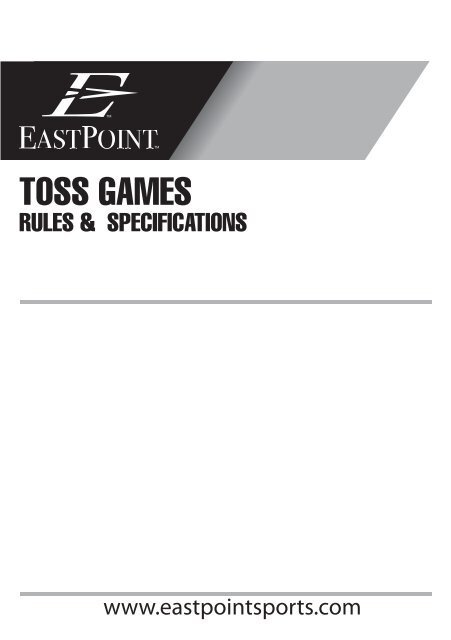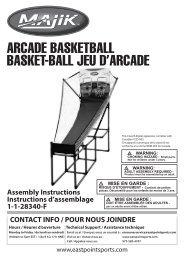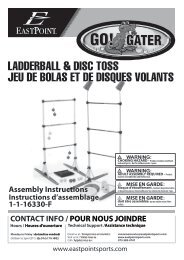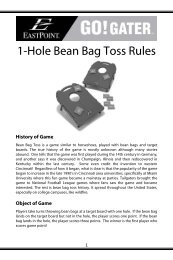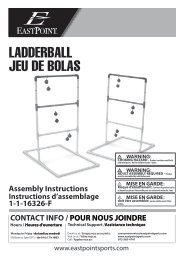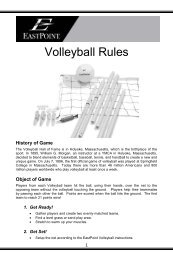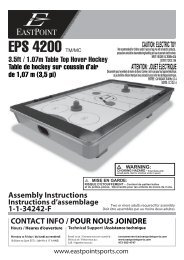You also want an ePaper? Increase the reach of your titles
YUMPU automatically turns print PDFs into web optimized ePapers that Google loves.
<strong>TOSS</strong> <strong>GAMES</strong>RULES & SPECIFICATIONS
INTRODUCTIONAbout <strong>EastPoint</strong> <strong>Sports</strong><strong>EastPoint</strong> <strong>Sports</strong> designs and delivers home recreational products that offer thebest price-value relationship in the industry. Our talented and creative team isunmatched in their experience and pride. Our innovative approach to all aspectsof our business enables us to provide products that are enjoyable for ourconsumers. We take pride in our products, and at the end of the day, we areproud to share them with family, friends, and our consumers because theyrepresent quality, innovation, value and fun.Our <strong>EastPoint</strong> <strong>Sports</strong> team is always striving to provide our consumers with greatnew products at a great value. We are passionate about our products and takegreat satisfaction knowing that our hard work results in a quality product thatoffers individuals and families hours of enjoyment. At <strong>EastPoint</strong> <strong>Sports</strong>, family,friends, and fun are the name of the game. This is how we have fun and wehope you do too!Why Play Toss Games?Playing toss games is fun! Also, playing toss games can increase physicalactivity. Regular physical activity has many proven health benefits including thefollowing: Stronger bones; Reduced stress and anxiety; Reduced blood pressure; Increased self-esteem; and Healthier body weight.How Do You HELP Make <strong>EastPoint</strong> Products More Fun?Submit your own house rules or product invention ideas online atwww.eastpointsports.com.Do You Need More Information?Visit us online at www.eastpointsports.com for more information.1
TABLE OF CONTENTSIntroduction ...................................................................... pg 1Ladderball ...................................................................... pg 3Bean Bag Toss – 1 Hole ...................................................... pg 7Bean Bag Toss – 3 Hole ...................................................... pg 11Washer Toss ...................................................................... pg 14Tic-Tac-Toss ...................................................................... pg 17Disc Toss ...................................................................... pg 20Disc Target Toss ................................................................. pg 24Disc Golf ...................................................................... pg 26Lawn Darts ...................................................................... pg 30Electro Darts ...................................................................... pg 342
LadderballHistory of GameStories about Ladderball history are not proven, yet, they add to the fun of thegame. Here is one of them:The earliest story takes place between 1000-1500AD. According to this version,a Polynesian fisherman named Willieakahlua came up with the idea of hollowingout a couple coconuts and connecting them together with rope made frombraided kelp. He began throwing this homemade "bolo" up and down the beachand came across a fallen tree. He tried tossing the bolo over the tree, but it gotwrapped around a branch. He and his friends began to play together. Eventuallythey made up rules and the game, which became known as "Willyball."Eventually it got to the point where an annual championship was created andheld on the famous Easter Island. The winner of the tournament had a statuecreated in their honor. Too far-fetched too be true? You decide!In recent decades, Ladderball has experienced a boom in popularity. This newpopularity seems to have started in campgrounds. From there it spread tobackyards, campus life, and tailgating entertainment. The rest is Ladderballhistory!Object of GameLadderball can be played with singles or with teams. Each player or team takesturns throwing bolos at the opposing team’s or player’s ladder. A bolo is madeup of two golf-ball-sized balls attached by a cord. Ladder rungs are assignedpoint values, and the object is to throw the bolos so that they wrap around therungs of the opposing ladder. Points are accumulated after every round until oneteam or player reaches 21 points. The first team or player that reaches 21 pointswins!3
1. Get Ready!Before you begin, recruit one person (i.e., singles) or three people(i.e., teams) to play with you.Select a level playing area to set up the ladders where your play willnot impact other nearby tailgaters or cars. Consider safety first for allthrowing games!Stretch to wake up your muscles!2. Get Set!Setup the Ladderball ladders so that they face one another. SeeFigure A. Remember to put the rubber scoring ring over the ladderrung =that has the scoring scale. Each ladder needs one! A goodlocation is on top of the ladder, where it is easy to see and adjust thescore.The spacing between ladders will depend upon the playing areaavailable and the skill level of the players. Distances range fromabout 15 feet apart, for beginner players or for a smaller tailgatingspace, to 40 feet apart for experienced players if space permits.Pick teams, if playing with four people.Toss a coin to determine which team or player throws first. The loserof the toss picks the playing side.Assign bolo colors to each side.Try a few practice throws. Gentle overhand throws rotate forward, andmay improve your chances of scoring. Underhand throws rotatebackwards and work better for some players. Underhand throws byholding the bolo cord halfway between each ball may also work wellfor you.Figure A:Ladderball Setup3. Go! Play15 to 40feetBasic scoring rules:o Points are counted after both players or teams have thrown alltheir bolos, completing a round of play.o Keep scores verbally during play for everyone to hear, and tally4
Game TriviaYikes! Snakes in ladderball? One Ladderball story tells us that the gameoriginated in Mexico where people tossed live snakes at a fence forentertainment. Another story tells that when cowboys were spending a lot of timeon the range driving cattle or building fences, for entertainment they would tossrattle snakes at fence posts or stumps. They would score points by getting thesnakes hung up. Perhaps they used snakes because out on the range not muchelse was available to entertain. No snakes are harmed in playing Ladderball!6
One-Hole Bean Bag TossHistory of GameBean Bag Toss is a game similar to horseshoes, played with bean bags andtarget boards. The true history of the game is mostly unknown although manystories abound. One tells that the game was first played during the 14th centuryin Germany, and another says it was discovered in Champaign, Illinois and thenrediscovered in Kentucky within the last century. Some even credit the inventionto western Cincinnati! Regardless of how it began, what is clear is that thepopularity of the game began to increase in the late 1990’s in Cincinnati areauniversities, specifically at Miami University where this fun game became amainstay at parties. Tailgaters brought the game to National Football Leaguegames where fans saw the game and became interested. The rest is bean bagtoss history. It spread throughout the United States, especially on collegecampuses, like wildfire.Object of GamePlayers take turns throwing bean bags at a target board with one hole. If thebean bag lands on the target board but not in the hole, the player scores onepoint. If the bean bag lands in the hole, the player scores three points. Thewinner is the first player who scores game point!1. Get Ready!Before you begin, recruit one person (i.e., singles) or three people(i.e., two teams) to play with you.Select a level playing area where your play will not impact othernearby activities. Consider safety first for all throwing games!Stretch to wake up your muscles!7
2. Get Set! Place the two target boards a convenient distance apart; 10 to 25 feetworks well for most game play. See Figure B. Pick teams, if playing with four people. Toss a coin to determine which player or team throws first. Assign a bean bag color to each player or team. Try a few warm up shots.Figure B:One-Hole Bean Bag Toss Setup3. Go! Play10’ to 25’feetBasic scoring rules:o Keep scores verbally during play for everyone to hear.o Invisible foul lines exist from the edge of each target box. Playersmay not cross this line when throwing. These “foot fouls” result inthe loss of that throw and any score it may have gained.o Back up so that you stay behind the front edge of each targetboard if you need more room to wind up and throw, to avoid footfouling.o Bean bags landing on the target board or in the hole that werethrown during a foot foul must be removed from the playing area.o Bean bags lying on top of the target board which are knockedinto the hole by a foul bean bag must be returned to their originalscoring position before play can resume.o Any bean bag that leaves a player’s hand once the arm swingscounts as a throw.o Bean bags thrown in the hole score three points each. They mustbe totally inside the hole to count.o Bean bags landing on top of the target board or hanging into thehole, but not in the hole, score one point each.o Bean bags thrown on the ground or out of the playing area, scorezero points each.o Similar to horseshoes, bean bags for opposing players on agiven round cancel one another out.o Any throws that bounce off tree limbs or any other obstructionsare considered foul, and receive no score.8
Game play:o In singles play, players walk back and forth between targetboards together as play unfolds. For team play, players split up,with one member at each target board, similar to horseshoes.o Winner of the coin toss pitches all their bean bags to the targetboard on the opposite end, and waits for the opponent to throw.After the first round, players and teams alternate who goes first.o In singles play, once all the bean bags have been thrown, the twoopponents walk down to the target board and tally any points thatwere made. Once scoring for that round is decided and tallied,both players will continue playing towards the other target board,repeating this process until one player wins the game.o In team play, players from both teams take turns to throw theirbean bags to the other target board where their teammates arewaiting. When these throws are complete, the other two playerswill mutually decide on the scores. When this first round isscored, play begins in the opposite direction. The first twoplayers who initially threw will now watch game play, and scorethe incoming bean bags.o Work out any score discrepancies before continuing play.o Play continues until the game point of 21 is reached. If scores aretied at 21, play one more round. Winner of the next round, winsthe game.Game VariationsEasier GameEliminate the foul line rule from the game. This is one less rule to follow andmakes playing with inexperienced, special-needs, or young players easier. Alsoto make this game easier, shorten the distance between target boards.Everyone can enjoy this wonderful game!9
Game TriviaDo you know these bean bag toss terms?Blocker - A bean bag that lands in front of the hole blocking the holefrom sliding bean bags who might have otherwise made it in the hole.Frame - When both players throwing their four bean bags. After eachplayer has thrown four bean bags, the score is calculated and a newframe begins.Gusher or Double Deuce - Four holes made by a single player in asingle frame.Leprechaun - When a player attains all four bags onto the boardwithout getting any into the hole.Power Wash -A round in which all four bags from each opposingplayer land on the board, causing the round score to be zero, a wash.Pressure Cooker - When both players on one end continually negateeach others scores thus creating a very tense situation.10
Three-Hole Bean Bag TossHistory of GameBean Bag Toss is a game similar to horseshoes, played with bean bags andtarget boards. The true history of the game is mostly unknown although manystories abound. One tells that the game was first played during the 14th centuryin Germany, and another says it was discovered in Champaign, Illinois and thenrediscovered in Kentucky within the last century. Some even credit the inventionto western Cincinnati! Regardless of how it began, what is clear is that thepopularity of the game began to increase in the late 1990’s in Cincinnati areauniversities, specifically at Miami University where this fun game became amainstay at parties. Tailgaters brought the game to National Football Leaguegames where fans saw the game and became interested. The rest is bean bagtoss history. It spread throughout the United States, especially on collegecampuses, like wildfire.Object of GamePlayers take turns throwing bean bags at a target board with three holes. Eachhole scores a different amount of points. The winner is the first player whoscores game point!1. Get Ready!Before you begin, recruit one person (i.e., singles) or three people(i.e., two teams) to play with you.Select a level playing area where your play will not impact othernearby activities. Consider safety first for all throwing games!Stretch to wake up your muscles!11
2. Get Set! Place the two target boards a convenient distance apart; 10 to 25 feetworks well for most game play. See Figure C. Pick teams, if playing with four people. Toss a coin to determine which player or team throws first. Assign a bean bag color to each player or team. Try a few warm up shots.Figure C:Three-Hole Bean Bag Toss Setup10 to 25 feet3. Go! PlayBasic scoring rules:o Keep scores verbally during play for everyone to hear.o Invisible foul lines exist one step from the edge of each targetbox. Players may not cross this line when throwing. If they do,the player loses that turn and any point from that throw will notcount.o Opposing player points in the same holes do not cancel oneanother. All bags thrown into holes count.o Bags hanging into a hole that rest on the target board do notcount for points.o Bean bags missing the target board altogether, or landing on theboard receive no points.o The first player or team to reach 100 points wins the game.o Let’s get tossing!Game play:o Winner of the coin toss throws first.o Aim at the holes in the far target board. One player throws at atime, then the other. Players alternate turns, throwing their beanbags at the target boards until all the bean bags have beentossed.o In singles play, once all the bean bags have been thrown, the twoopponents walk to the target board and tally any points that weremade. Once scoring for that round is decided, both players willcontinue playing towards the other target board, repeating thisprocess until one player wins the game.12
ooIn team play, players from both teams take turns throwing theirbean bags to the opposite target board where their teammatesare waiting. When these throws are complete, the other twoplayers count the score. When this first round is scored, playbegins in the opposite direction. The first two players who initiallythrew will now watch game play, and score the incoming beanbags.Play continues back and forth until one side scores 100 points. Ifscores are tied at 100, play one more round. Winner of the nextround, wins the game.Game VariationsEasier GameShorten the distance between the two target boards. This makes playing withinexperienced, special needs, or young players easier. Everyone can enjoy thisfun game!Game TriviaDo you know these bean bag toss terms?Airmail - When a bean bag lands directly in the hole without makingany contact with other areas of the board.Slider -A beanbag that slides into the hole.Hanger -A beanbag on the lip of the hole that is ready to drop.Honors - The team who tosses first, resulting from the team scoringlast.Jumper -A bean bag that strikes another bag on the board causing itto jump up into the hole.13
Washer TossHistory of GameOrigin stories about washer toss are not proven, yet, they add to the fun of thegame. Take a look at these stories about how washer toss started and decidewhich ones you want to believe:The earliest stories of washer toss date back thousands of yearswhen the Egyptians and Mayan's played a variation of the washertoss game during the height of their empires.A more commonly found story is that the washer toss game originatedover 100 years ago when American cowboys removed woodenwheels from wagons and tossed washers at the hub as a way to passtime.One story tells that the game picked up popularity in Texas oil fields.People tossed oversized washers at holes in the ground as a way topass time during work breaks.What we do know is that in the 1980's, washer toss’s popularity spread to Texascommunities. Charities began to pick up on the popularity of the game and beganhaving washer toss game tournaments to raise money. Some of the charitiesincluded Houston Livestock Show and Rodeo; American Cancer Society; and theSan Jacinto Day Foundation. The high profile tournaments helped spread thepopularity of the game throughout Texas. In the last decade, the washer tossgame has become better known across America. This game remains a greatway to entertain friends and family.Object of GameIn this challenging game, each player or team takes turns tossing washers into abox that has a cylinder center cup. Points are awarded for each washer that is14
tossed into the box, and extra points are awarded for landing a washer into thecenter cup. Play continues until a player or team scores the game point.1. Get Ready!Before you begin, recruit one person (i.e., singles) or three people(i.e., teams) to play with you.Select a level playing area to set up the ladders where your play willnot impact other nearby tailgaters or cars. Consider safety first for allthrowing games!Stretch to wake up your muscles!Look out for washers hiding in deep grass or runaway washers onpavement!2. Get Set! Setup the Washer Toss boxes so that they face one another about 5to 10 feet apart. See Figure D. Pick teams, if playing with four people. Toss a coin to determine which team or player throws first. Similar to the game of horseshoes, washers land best when tossedunderhand. Place a small amount of backspin on the washer to helpit stay in the box or cup, or try throwing like a flying disc. Practice your toss.Figure D:Washer Toss Setup3. Go! PlayBasic scoring rules:o Keep scores verbally during play for everyone to hear. Keeptrack of the score as you play.o Washers missing the box entirely are awarded no score.o Washers landing inside the box are worth one point.o Washers landing in the cup are worth three points.o The first player or team to reach 21 points wins the game! Game play:o Similar to horseshoes, team members split up, with one memberat each box.15
ooooooWhen playing singles, opponents toss from the same side.Each round consists of players taking turns throwing threewashers into the target box.Watch out for get-away washers, especially on pavement! Stopplay until stray washers are captured.Do not walk to the opposite box or get in the line of toss prior tothe completion of all throws. An exception is if play halts due to arunaway washer.Switch boxes after the first player or team reaches 11 points.Play continues until one player or team reaches 21 points andwins!Game VariationsExtreme PlayTo make the game harder, increase the distance between boxes to more thanten feet. The farther apart the boxes are, the harder it will be to land washers intothe box and cup! How extreme do you want to play!?Easier GameShorten the distance between the two boxes to 2 to 4 feet. This makes playingwith inexperienced, special needs, or young players easier. Everyone can enjoythis fun game!Quicker Game PlayPlay shorter games to either 7 or 11 points for quicker game play.Game TriviaIn the Sai Kung area of Hong Kong, a variant of the washer toss game, known as"Holeyboard," has become popular amongst locals living in the area. It is usuallyplayed on the roof terrace of a participant's home and a unique and different setof rules have evolved over the years. A "cycle," the highest accolade inHoleyboard, is when a player manages to hit three holes with their threewashers. This results in an instant win and is rewarded by the player being ableto sign his name on the back of the Holeyboard. One famous player, known asthe “Smart Bomb” for his accuracy, is known to have scored 37 cycles in only ashort two-year Holeyboard career!16
Tic-Tac-TossHistory of GameTic-Tac-Toss is a game similar to Bean Bag Toss and Tic-Tac-Toe, played withbean bags and a target board. An early version of Tic-Tac-Toe was said to beplayed in the Roman Empire, called Terni Lapilli. Each player only had threepieces, so they had to move them around to empty spaces to continue play. Tic-Tac-Toe grid markings have been found chalked throughout Rome. However,some say that Tic-Tac-Toe could originate back to ancient Egypt. With thepopularity of Bean Bag toss for tailgating parties, especially on collegecampuses, Tic-Tac-Toss takes Tic-Tac-Toe to the next level!Object of GamePlayers take turns throwing bean bags at the grid boxes on a target board. Thewinner is the first player who has three bags in a row either horizontally, verticallyor diagonally!1. Get Ready!Before you begin, recruit one person (i.e., singles) or three people(i.e., two teams) to play with you.Select a level playing area where your play will not impact othernearby activities. Consider safety first for all throwing games!Stretch to wake up your muscles!17
2. Get Set! Place the target board at a convenient distance; 10 to 25 feet workswell for most game play. See Figure E. Pick teams, if playing with four people. Toss a coin to determine which player or team throws first. Assign a bean bag color to each player or team. Try a few warm up shots.Figure E:Tic-Tac-Toss Setup3. Go! PlayBasic scoring rules:o Invisible foul lines exist at the front edge of each target board.Players may not cross this line when throwing. These “foot fouls”result in the loss of that throw.o Bean bags that land into a grid box “own” the box and remainthere until the game is over. Any bags that land in this same boxmust be removed.o Any bean bag that leaves a player’s hand once the arm swingscounts as a throw.o Any throws that touch the ground, bounce off tree limbs or anyother obstructions are considered foul, and receive no score. Game play:o Winner of the coin toss pitches one bean bag onto the grid boxtarget board. Then the opponent pitches one bean bag.Players/teams continue alternating throws until all bean bagshave been thrown.o After the first round, players and teams alternate who goes first.o Work out any score discrepancies before continuing play.o Any “foul” bags or bags not in a grid box are removed and thrownagain in round two.o Play continues until either (a) one player/team has three in a row;or (b) all nine squares are filled.a) If a player/team has placed three of their colored bags ina row, either horizontally, vertically or diagonally, thatplayer/team wins.b) If all nine squares are filled and neither player/team hasthree in a row, the game is a draw.18
Game VariationsEasier GameMake this game easier for inexperienced, special-needs, or young players.Shorten the distance between to the grid box target boards. This makes playingwith inexperienced, special needs, or young players easier. Everyone can enjoythis fun game!Knock OutPlayed like the regular Tic-Tac-Toss game, Knock Out allows an opponent’scolored bag that occupies a grid box to be “knocked out” or replaced by aplayer’s/team’s successful toss into the occupied grid box. It makes for a moreaggressive and fun game!Misère Tic-Tac-TossContrary to the regular game of Tic-Tac-Toss, a player wins if the opponent getsthree bags in a row.Game TriviaTic-Tac-Toe has different names in different countires. "Noughts and Crosses",the British name, appeared first in print in 1864. An old 1558 version ofbackgammon called, “tick-tack” may also be the name origin. The game iscalled “Xs and Os” in Ireland and “X and 0” in India. The U.S. renamed Noughtsand Crosses to Tic-Tac-Toe sometime in the 20th century.19
Disc TossHistory of GameDisc toss history is unique in that its one of the very few outdoor games enjoyedtoday that was established less than 50 years ago. The year 1926 is the earliestrecorded history of anyone playing a form on this game. In Vancouver, BritishColumbia, schoolchildren developed a game to play on the playground in whichthey would throw tin lids at targets. They named the game "Tin Lid Golf." Sincethen, many variations of disc games are played and well loved throughout theworld. Of them all, Disc Toss games are our favorites!Object of GameDisc Toss is a target game. Each team takes turns throwing a disc at an<strong>EastPoint</strong> <strong>Sports</strong> Ladderball ladder. On the two ladder uprights are upside downcups. The throwing team must either knock the cups off by striking the ladderuprights or cups with the disc, or cleanly pass the disc between the ladders in theopening directly below the cups without making contact with the ladder. Thedefending team member stands behind the target ladder and is not allowed tointerfere with the throw, but may score points by catching a falling cup with onehand. Disc toss is won by the first player or team reaching 21 points!20
1. Get Ready!Before you begin, recruit one person (i.e., singles) or three people(i.e., teams) to play with you.Select a level playing area to set up the ladders where your play willnot impact other nearby tailgaters or cars. Consider safety first for allthrowing games!Stretch to wake up your muscles!2. Get Set!Setup the Ladderball ladders so that they face one another. Place twocups upside down on each ladder upright. See Figure F.The spacing between ladders will depend upon the playing areaavailable and the skill level of the players. Distances range fromabout 10 to 15 feet apart. Increase the distance for experiencedplayers.Pick teams, if playing with four people.Toss a coin to determine which team or player throws first. The loserof the toss picks the playing side.Play singles with opponents throwing from the same side. Pick twoteams of two for doubles. Opposing teams split up with one memberof each team one different ends, similar to horseshoes.Try a few practice throws. Let’s go!Figure F:Disc Toss Setup10 to 15 feet21
3. Go! PlayBasic scoring rules:o Keep scores verbally during play for everyone to hear, and tallythe score using the sliding ring on top ladder rung at the end ofeach round.o Two points are awarded to the throwing team each time the discis thrown through the ladder scoring area without touching theladder frame. To score in this way, the disc must pass throughthe space between the two uprights, above the top ladder rung,and below the two cups.o The throwing team receives one point for knocking a cup off anyupright.o One point is awarded to the defense for each cup caught. Cupsmay only be caught with one hand. Catching the cup between ahand and the body (called “trapping”) and two-handed catchesare not allowed. The throwing team receives one point for everycup that is “trapped” or “two handed” by a defender during anattempted catch as an incentive to prohibit catching a fallen cupin this manner.o If the disc hits the ground, does not hit a cup, or does not gothrough the scoring area, no points are awarded.o If the disc hits the ladder, but the cup does not fall off, no pointsare awarded.o If a cup is accidentally knocked off the ladder by a player’s body,the opposing team is awarded a point for each cup that touchesthe ground in this manner.o The first player or team to reach 21 points wins the game. Game play:o Teams or individuals take turns throwing the disc towards theladders. Each offensive round consists of throwing two discs atthe opponent’s ladder.o If the disc hits a cup, ladder, or uprights and the cup becomesairborne, the point is up for grabs. If the cup hits the ground, thethrowing team is awarded the point. If the defending playercatches the cup with one hand before it hits the ground, they winthe point. If the defending player tries to catch the cup with onehand but fails, the offensive team scores an additional point.o After two throws by the offense, any fallen cups are replaced onthe ladder and it becomes the defending team’s turn to throw thediscs to score points.o Interfering with the disc before it flies past the ladders is notallowed. Should this occur, the throwing team is awarded anothertry.o Teams switch sides after a team reaches 11 points.o Play continues until one side reaches 21 points and wins thegame.22
Game VariationsBeach Disc TossPlay Disc Toss at the beach!Extreme PlayIncrease the distance between ladders to 30 feet or more if there is availablespace to safely play. This adds to the game difficulty.Easier GameThe “no trapping” and “two-handed catch” rules may be suspended to make thegame easier.Disc Toss with Three Scoring AreasUse the spaces between the ladder rungs for additional scoring areas. Assignthe lowest scoring area 3 points, the middle scoring area 2 points, and theregular and top scoring area 1 point.Game TriviaIn the early 1960’s, a man named Fred Morrison created a primitive version oftoday's flying disc that he called the "Pluto Platter."23
Disc Target TossHistory of GameDisc toss history is unique in that its one of the very few outdoor games enjoyedtoday that was established less than 50 years ago. The year 1926 is the earliestrecorded history of anyone playing a form on this game. In Vancouver, BritishColumbia, schoolchildren developed a game to play on the playground in whichthey would throw tin lids at targets. They named the game "Tin Lid Golf." Sincethen, many variations of flying disc games are played and well loved throughoutthe world. Of them all, Disc Toss games are our favorites!Object of GameDisc Target Toss is a target game. In this version of the game, each team takesturns throwing a disc at a net with target pockets. The throwing team scores apoint when the disc lands in a target pocket. The defending team member standsbehind the target ladder and is not allowed to interfere with the throw. Disc toss iswon by the first player or team reaching 11 points!1. Get Ready!Before you begin, recruit one person (i.e., singles) or three people(i.e., teams) to play with you.Select a level playing area to set up the net where your play will notimpact others nearby. Consider safety first for all throwing games!Stretch to wake up your muscles!24
2. Get Set!Setup the net according to the instructions provided.Pick teams, if playing with four people.Toss a coin to determine which team or player throws first.Try a few practice throws. Let’s go!3. Go! PlayBasic scoring rules:o Keep scores verbally during play for everyone to hear.o One point is awarded to the throwing team each time the disc isthrown into a target pocket.o If the disc hits the ground, no points are awarded.o The first player or team to reach 11 points wins the game. Game play:o Teams or individuals take turns throwing the disc towards thetarget pockets.o Interfering with the disc in flight is not allowed. Should this occur,the throwing team is awarded another try.Game TriviaThe current world distance record was set in 1998 by a man fromColorado who threw a flying disc more than 689 feet. In 1994, at theU.S. Open Flying Disc Championships, the women’s distance recordwas registered with a throw that flew over 446 feet.25
Disc GolfHistory of GameDisc Golf is a fun version of the sport that anyone can play. The origins of discgolf are impossible to pinpoint, since versions of the sport have been enjoyedeven before the plastic flying disc became a worldwide phenomenon!Hahamongna Watershed Park in Pasadena, California is known as the firstpermanent disc golf course in the world. Established in 1975, the course is a fanfavorite due to the challenge posed by thick groves of oak trees. The popularityof disc golf grew across the world and now, with Disc Golf, you can play in yourown backyard!Object of GameLike regular golf, disc golf is won by the player with the lowest score. Players setup their own disc golf course using the disc golf target holes. Players decide thenumber of holes in their course and the PAR at each hole. PAR is the averagenumber of throws it takes players to land their discs in the hole. At each hole,players take turns throwing their disc to try to land it in the hole with the fewestnumber of throws. The player who has completed all holes with the lowest scorewins.1. Get Ready!Before you begin, recruit one to three other players to play with you.Select a playing area where your play will not impact other nearbyactivities. Consider safety first for all throwing games!Get paper and pencils to keep score. You may use or copy thesample scorecard provided in this Rule Book, or make your own.Stretch to wake up your muscles!2. Get Set! Agree on how many holes the game shall include. Possibilities26
include 2 to 18.Place the target hole(s), in the desired location(s). Create your ownDisc Golf course using natural elements, such as trees, bushes, andelevation changes to make the course more challenging.Before teeing off on each hole, agree on the PAR for that hole usingthe guide in Figure G below.Agree on tee locations. The tee is where a player stands when firstthrowing their disc for a hole.Try a few warm up throws. Grip the disc as shown in Figure H below.Assign a disc color to each player.Decide tee off order by flipping discs. The printed side is heads upand the other side is tails. For more than two players, every playerflips their disc and the one who receives a different disc side than theother players, tees off first.Figure G:PAR Guide for Target HolesDistance from Tee to TargetPAR*30 feet (10 meters) 330 – 60 feet (10 -20 meters) 4More than 60 feet (20 meters) 5*In some circumstances, teammates may agree ahead of time on higher PAR numbersthan the ones suggested in Figure A. These circumstances may include new, young, orspecial needs players; or course obstacles like trees, bushes, or changes in elevation.Figure H:Disc Grip27
3. Go! PlayEach player carries their disc to the first tee.The winner of the disc flip stands at the tee and throws first. This iscalled a “stroke.”The remaining players take turns now teeing up and throwing theirdisc towards the first hole.Allow each player to throw without distraction. Players wait their turnand tee up after the previous player’s disc has landed.After teeing off, the player whose disc is furthest from the hole goesfirst. Then, players alternate turns until both players have thrown theirdisc into the hole.Basic scoring rules:o Try to make the fewest number of strokes.o Count the number of strokes it takes each player before their discenters the hole. Compare players’ numbers to the PAR and keepscore using the Disc Golf Scorecard.o The disc must be entirely inside the hole as shown in Figure I. Adisc landing on top of or leaning up against the hole is notconsidered “in.”o The player with the lowest score at the last hole will begin play atthe next hole.o Repeat play until all the holes are complete. The player with thelowest total score after the last hole wins the Disc Golf match!Figure I:A Scoring DiscIn Not In Not InDisc Golf ScorecardPlayer Hole 1 Hole 2PAR=__ PAR=__Hole 3PAR=__Hole 4PAR=__Hole 5PAR=__Hole 6PAR=__Hole 7PAR=__Hole 8 Hole 9PAR=__ PAR=__Game28
Game play:o Each player carries their disc to the first tee.o The winner of the disc flip stands at the tee and throws first. Thisis called a “stroke.”o The remaining players take turns now teeing up and throwingtheir disc towards the first hole.o Allow each player to throw without distraction. Players wait theirturn and tee up after the previous player’s disc has landed.o After teeing off, the player whose disc is furthest from the holegoes first. Then, players alternate turns until both players havethrown their disc into the hole.Game VariationsEasier GameShorten the distance between tees and targets. This makes playing with young,inexperienced, or special needs players easier. For quicker game play, after teeoff, allow less skilled players to throw the disc from where the closest disclanded. Everyone can enjoy this game!Harder GameLengthen the distance between tees and targets. Place targets behind trees,rocks, or other obstacles to increase the difficulty. This creates an additionalchallenge for expert players.First One InSkip PAR scoring and use this rule for quick game play. The first player whosedisc lands in the hole scores 1 point. After a point is scored by 1 player, allplayers move on to the next hole. This continues until all the holes have beenplayed. The player with the highest score, wins the match!Select A SideBefore teeing off, the first player must call which hole on the target will be thescoring hole. Target holes have three directions that a disc can enter the target:right, left, and back. If the shot is called and the player's disc does not enter thetarget as called, then no point is scored and play continues on that hole.Game TriviaIf a player scores 3 throws under PAR (-3), it is called an “albatross.” Scoring 2throws under PAR (-2) is called an “eagle” and 1 throw under PAR (-1) is called a“birdie.”29
Lawn DartsHistory of GameLike many other games including Horseshoes, Bocce, and Darts, Lawn Darts is atarget game. Throwing an object at a target may be the oldest game on theplanet. While Lawn Darts, as we know it today, originated in the 1950s, it issimilar to the ancient Roman plumbata, lead-weighted darts carried byinfantrymen in the Middle Ages. In 1988, Lawn Darts with sharp points werebanned for sale by the Consumer Product Safety Commission in the UnitedStates. Today, Lawn Darts are made with a blunt weighted tip resulting in a safeversion of the game.Object of Game<strong>EastPoint</strong> Lawn Darts is a target game where the object is to throw the darts sothat the weighted tip lands inside a plastic ring. The first player or team to reach apre-agreed score wins the game. Players score one point for every dart whichlands within the ring. Lawn darts from opposing players within the ring canceleach other out. Two opposing players, or two teams of two players may play<strong>EastPoint</strong> Lawn Darts. This game is easy to learn, simple to play, but difficult tomaster.1. Get Ready!Gather one other player or three other players and create two teams.Select an open area without overhead objects, such as clotheslines ortrees, and about 10 feet wide and 50 feet long.Stretch to warm up your muscles.30
2. Get Set!Place the two target rings about 35 feet apart. The distance betweentarget rings may be decreased for younger players, or increased toabout 60 feet for a more challenging game, if space permits.Watch out for people and pets in the playing area. The players andspectators not currently throwing a Lawn Dart are responsible forwatching to make sure that the game area is safe. They areresponsible for alerting both the throwing player of unsafe conditions,and any nearby people or pets to stop and stay away from the path ofthe Lawn Dart. It is the thrower’s responsibility to be watchful beforeswinging and releasing the Lawn Dart.Practice throwing the Lawn Darts. To throw one, hold it from the top,not the blunt tip, and toss underhand. See Figure J.<strong>EastPoint</strong> Lawn Darts must land with the weighted tip inside the targetring to count for a point. If the tip rests on top of the target ring for anyreason, more than half the tip must be inside the ring to count as apoint. See Figure K.Decide on game points before starting the game. Possible gamepoints include 3, 15, or 21 points.Flip a coin to determine the player or team who throws first to beginthe game.Figure J:Throwing the <strong>EastPoint</strong> Lawn Dart31
Figure K:Scoring for Lawn DartsININOUT3. Go Play!Keep score verbally.A point is scored when a Lawn Dart lands in the target ring. However,if a player lands a Lawn Dart in the target ring, and then an opposingplayer also lands a dart in the target ring, the scores cancel eachother out. For example, if Team A landed two Lawn Darts in thetarget ring and Team B landed one Lawn Dart in the target ring, TeamA would score one point and Team B would score no points.Game VariationsHandly Cup Style Lawn DartsIn Handly Cup Style Lawn Darts, points are given for Lawn Darts landing in thetarget ring plus darts closer to the ring than any of the opposing team's darts.Darts that land inside the ring are worth 3 points each, and any Lawn Dartoutside the ring that is closer to the ring than any other Lawn Dart by theopposing team is worth one point. For example, if neither team managed to placea dart inside the ring, but one team had two Lawn Darts closer than any of theopposing team’s Lawn Darts, the team would score 2 points. A Lawn Dartthrown inside the ring can be cancelled by an opposing team also throwing a dartinto the ring. If both teams have darts in the ring, then no darts outside the ringmay score.32
Handly Cup Style matches usually are played with two teams which alternatethrows and keep track of points, until one team scores a total is 21 or more.Game TriviaThe F-16 Fighter Falcon aircraft was nicknamed the “Lawn Dart” dueto its resemblance and nine crashes that occurred in 2007.33
Electro DartsHistory of GameElectro Darts is a new spin on the traditional game, Lawn Darts. Electro Dartshas all the same features as Lawn Darts, but also has an electronic target withaudio output that indicates the score of each throw that lands on the target.Electro Darts is a versatile indoor-outdoor game that is fun for all ages.Like many other games including Horseshoes and Bocce, Electro Darts is atarget game. Throwing an object at a target may be the oldest game on theplanet. While Darts, as we know it today, originated in the 1950s, it is similar tothe ancient Roman plumbata, lead-weighted darts carried by infantrymen in theMiddle Ages. In 1988, Lawn Darts with sharp points were banned for sale by theConsumer Product Safety Commission in the United States. Today, Lawn Dartsand Electro Darts are made with a blunt weighted tip resulting in a safer versionof the game.Object of GameElectro Darts is a target game where the object is to throw the darts so that theweighted tip lands inside a target. After all of the darts are thrown at the target,the players then walk to the electronic target to retrieve their darts to continueplay. In Electro Darts, the first player or team to reach a pre-agreed score winsthe game. This game is easy to learn and simple to play, but difficult to master.Electronic Dart players score points according to the audio output of theelectronic target. The electronic target has four scoring areas within the target.There are two scoring areas for 10 points each, one for 20 points, and one for 30points. When a dart lands on one of the scoring areas inside the electronictarget, the audio output indicates how many points were scored on that throw.34
1. Get Ready!2. Get Set!3. Go Play!Gather one to three other players and create two teams.Select a safe, open area without overhead objects that mayinterfere with game play.Stretch to warm up your muscles.Place the electronic target on the ground. Select a foul line 5 to10 feet away from the target for younger players or 20 to 30 feetaway for more experienced players.Watch out for people, pets, and other obstacles in the playingarea. The players and spectators not currently throwing a dartare responsible for watching to make sure that the game area issafe. It is the thrower’s responsibility to watch out for people,pets, and other obstacles before swinging and releasing theElectro Dart.To throw an Electro Dart, hold it from the top, not the blunt tip,and toss underhand. Practice throwing the Electro Darts.Decide on game points before starting the game. Possiblegame points include 100 or 200.Electro Darts must land with the weighted tip inside theelectronic target to receive a score that audibly sounds whenthe Electro Dart hits the target.Flip a coin to determine the player or team who throws first tobegin the game.Verbally keep track of the score for each player or team.When all the Electro Darts are thrown, players retrieve theirdarts and continue the next round of play.The first player or team to score game point or higher, wins thegame.GAME VARIATIONSLawn DartsElectro Darts comes with plastic target rings so players can also play traditionalLawn Darts. Here are the instructions for this game: Place the two target rings about 35 feet apart. The distancebetween target rings may be decreased for younger players, orincreased to about 50 feet for a more challenging game, ifspace permits. Watch out for people, pets, and other obstacles in the playing35
area. The players and spectators not currently throwing a dartare responsible for watching to make sure that the game area issafe. It is the thrower’s responsibility to watch out for people,pets, and other obstacles before swinging and releasing theLawn Dart.<strong>EastPoint</strong> Lawn Darts must land with the weighted tip inside thetarget ring to count for a point. If the tip rests on top of the targetring for any reason, more than half the tip must be inside thering to count as a point.Decide on game points before starting the game. Possiblegame points include 3, 15, or 21 points.Flip a coin to determine the player or team to throw first to beginthe game.The first player or team to throw selects their dart color.The target rings serve as the foul line and players must standbehind their target ring when throwing a dart.Verbally keep track of the score for each player or team.When playing with two players, each player goes to oppositetarget rings. The player who throws first throws all the darts tothe opposite target ring. When all the darts have been thrown,the opposing player picks up the darts and then takes a turn tothrow them to his or her opposing target ring. Play continueslike this until game point is reached.When playing with four players, a player from each team goesto each target ring. The player who throws first, throws onedart. Then the opposing team’s player at the same target ringthrows a dart. They alternate turns until all the Lawn Darts arethrown. Then, the two players at the opposite target ring pick upthe Lawn Darts, divide them equally using the correct teamcolors, and they alternate turns throwing until all the Lawn Dartsare thrown. Play continues like this until game point is reached.A point is scored when a Lawn Dart lands in the target ring.However, if a player lands a Lawn Dart in the target ring, andthen an opposing player also lands a dart in the target ring, thescores cancel each other out. For example, if Team A landedtwo Lawn Darts in the target ring and Team B landed one LawnDart in the target ring, Team A would score one point and TeamB would score no points.The first player or team to score game point or higher, wins thegame.36
GAME TRIVIAThe Lawn Dart is based on its smaller cousin, the dart, used for throwing at anupright target board. The dart and target board have been around for centuries.Where did they originate? Historians report that darts were invented in MedievalEngland and were originally smaller versions of the traditional arrow. Thedartboard may have originated from the cross-section of a tree. As the wooddried, cracks developed, creating "sections" that may have been assigned pointvalues.37
www.eastpointsports.com628 ROUTE 10, SUITE #5 WHIPPANY, NEW JERSEY 07981 • 1-973-585-4747


